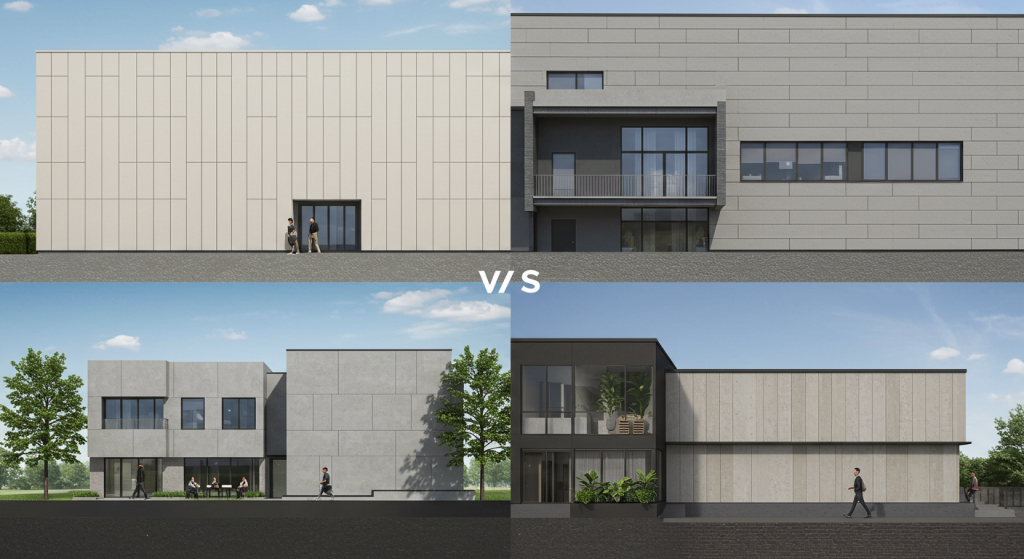Cost Comparison Between ACP and Fibre Cement Cladding: Guide
What Exactly is ACP?
An aluminum composite Panel (ACP) is a flat panel consisting of two thin sheets of aluminum that have been glued to a non-aluminum core. It’s sleek and modern, contemporary-looking, which makes it lightweight. Used mostly for commercial buildings, ACP provides a smooth surfaced V-grooved Panel ribbed, which comes in numerous colors alongside metallic finishes.
What About Fibre Cement Cladding?
Fiber cement cladding consists of sand, cement, and cellulose fibers blended in certain proportions. Unlike traditional wood or masonry styles, it adopts their appearance while being more durable with lower maintenance requirements, making it appropriate for both residential and commercial buildings.
Which Investment is More Wise?
Selecting wall cladding for a building's outer layer can influence aesthetics, cost, performance, and upkeep. Currently, two of the most popular choices are Aluminum Composite Panels (ACP) and Fibre Cement Cladding. In this article, we will undertake an extensive cost comparison between ACP and fibre cement cladding, keeping installation expenses as well as long-term ROI in mind.
Pre-Construction Expenses
Costs of ACP Panels
Prices for ACP panels range from $4 to $12 per square foot, varying with brand, finish, and thickness. Fibre cement cladding is slightly more expensive than ACP panels, priced between $6 and $14 per square foot. This cost can be driven higher by premium finishes or thicker boards.
1. Labor and Installation Expenses
- Installation Cost: Save on Installation Fee ACP Cladding.
- Installation of ACP Panels is relatively light, which drives down installation costs. Average prices are between $2 and $5 per square foot.
2. Fibre Cement Cladding Installation Cost
Due to its weight, fibre cement board requires additional labor and equipment, which raises the price range to $4 to $8 per square foot.
3. Durability & Maintenance
The enhancements needed over time are equal in cost for both materials, but the overall maintenance burden is heavier on Fibre cement, while the lighter-maintenance ACP still scores high ergonomically, as it will not discolor like paint nor require periodic repainting.
Durability: ACP Vs Fiber Cement
• Lifespan of ACP: 15-20 years
• Lifespan of Fibre Cement: 30-50 years
Weather and Fire Resistance
• Fire Rating for ACP Panels
Generally, ACP panels do not have a fire rating. There are FR variants (fire-retardant), but they come at a premium.
• Fire Resistance of Fibre Cement
Fibre cement stands out as non-combustible and possesses superior fire resistance, especially in high-risk areas.
• Cladding Weather Resistance
About weather protection, both provide reasonable weather defense; fibre cement does better in harsher conditions, though. Thermal insulation, ACP, acoustic performance cladding, and sustainability of cladding materials.
• Environmental Impact Cladding
B fibre cement, because it consists of natural raw materials and can be recycled, is more eco-friendly. Sustainability does not fare well as it is manufactured through energy-intensive processes, despite being recyclable.
• Sustainability of Cladding Materials
Relative to ESG (environmental sustainability governance), here, fibre cement wins over ACP for its life-cycle duration and natural composition, outweighing artificial components in the latter.

Cost Effectiveness and ROI
• Cost effectiveness: Cladding Mounting Price
Though initially cheaper to install AC panels, their cost increases over time, surpassing expenses accrued due to upkeep reduced by longer use resulting from extended working-life spanACP panels' long durability advantage over fiber-cement panels.
• Cost Over the Lifecycle of Cladding
When estimating lifecycle costs, it's important to consider cost comparison between ACP and fibre cement cladding:
- Total Cost for ACP over its lifetime (20 years) – $18 to $25 per square foot, including material and maintenance.
- Total Cost for Fibre Cement over its lifetime (30 - 50 years) – $20 to $28 per square foot.
Long-Term Insight: Fibre cement cladding has proven cost-effective over the years. It is more economical compared to other options while projecting expenses long-term.
Considerations Based On the Application Type
• Comparison of Costs of Commercial Cladding
In high-rise and commercial buildings, ACP is often used because of its elegant aesthetics and ease of installation.
• Residential Cladding Cost
Fibre cement is preferred for residences as it has better thermal efficiency and features a classic, timeless aesthetic look, which greatly adds value to homes.
• Renovation Facade Considerations Cost
For your old facade renovation, fiber cement is super durable, while ACP is modern and cheaper-inspired. Exterior wall cladding cost, expense analysis of facades, and architectural cladding cost.
Key Takeaways
• ACP (Aluminum Composite Panel): Provides lower material and installation costs. Light with easy handling, it is suitable for fast turnaround commercial projects. However, its long-term durability is lackluster, provides low fire resistance unless rated for fire protection, and is environmentally unfriendly.
• Fibre Cement Cladding: Carries a higher price tag initially, but exceptional durability makes it last between 30 to 50 years. Outstanding characteristics include fire resistance, severe weather resilience, minimal upkeep over time, and eco-friendliness owing to the materials used in manufacturing.
• Best Choice for Budget-Friendly Projects: Needing a sleek look will make clients ACP admirers; they offer quick, inexpensive installation, which greatly benefits commercial use.
• Best for Long-Term Value: Electric cement is preferred for the safety and eco-friendly designs of homes and commercial buildings by property developers.
• Bottom line – style comes inexpensive cost with ACP while fibre cement gives dependable functionality.
Conclusion:
The choice between ACP and fibre cement cladding depends on individual priorities. If budget constraints are a priority, sleek ACP may provide an adequate solution. However, if long-term value paired with fire safety and durable construction elements is key, then sustainability-oriented customers will appreciate fibre cement options much more. For cost comparison between ACP and fibre cement cladding recommendations, visit our website, HSCS Decor.








